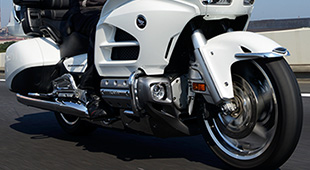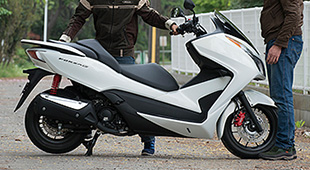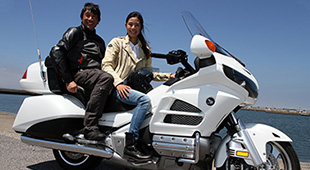Tech Views — Vol.10 Flangeless & Titanium Fuel Tanks
Titanium Fuel Tanks
PART2 -CRF450R, CBR1000RR SP / SP2 Titanium Fuel Tank
How Did Such a Fascinating Material Ever Come to Be Used?
The first titanium fuel tank ever featured on a mass-production motorcycle made its debut in 2017 on the newly updated CRF450R. That same year, a titanium fuel tank also appeared on the totally revamped CBR1000RR SP/SP2. Studies reveal that titanium has roughly 60% the specific gravity of steel, which means that if a piece of sheet steel weighs 1kg, then a titanium sheet of the same size and thickness will weigh 600g. Little wonder that this rarified material is highly effective in weight reduction. Another prime characteristic of titanium is its resistance to corrosion and rust.
Because of this, highly expensive parts for racing machines are individually cut out of blocks of titanium using advanced milling equipment. Titanium is also used to make exhaust pipes and silencers, as well as the intake valves and connecting rods used in their engines. It is generally recognized that titanium contributes to higher performance by making it possible to reduce weight while simultaneously increasing structural strength.
Titanium compares favorably with aluminum and carbon fiber as a lightweight and appealing material. It’s also interesting how bikes that incorporate such attention-getting lightweight materials are sold, since it imparts a sense of excitement greater than any performance numbers can reveal.
Among its plans for the manufacture of attractive looking fuel tanks, Honda’s Kumamoto Factory had recently introduced two new types of tank: one is the flangeless tank, and the other the titanium tank. Let’s find out the reason why titanium was selected for use on its CRF450R motocross machine, the first model to be equipped with a mass-produced titanium tank.
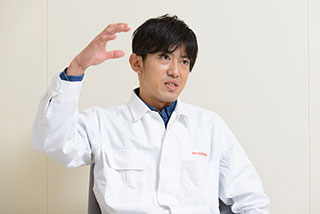
Kohei Hirano — CRF450R design engineering
"Up until the 2016 model, the CRF450R used a polyethylene tank. We were able to achieve considerably lighter weight by replacing this material with titanium. Since the tank is located in a position on the bike that’s higher than its center of gravity, lighter weight here would contribute to better centralization of mass and enhanced riding stability, which would, by extension, contribute directly to achieving higher performance and make it possible to build a stronger machine overall. With these ideas in mind, we decided to adopt the titanium tank.”

Yuki Chihara — Material research
“Polyethylene fuel tanks have be used for a long time on off-road racing machines because they easily recover their shape even after receiving strong impacts in crashes. However, due to the characteristics of current polyethylene tank manufacturing, it’s difficult to achieve a uniform thickness over the surface area of the entire tank, and sections that we might want to make thin end up becoming too thick. This in turn leads to heavier weight. In contrast, in the case of titanium tanks, assuming they’re press-molded, it’s possible to realize a uniform plate thickness, lighter weight and a slimmer shape.
“By making the tank slimmer, we were better able to make it easier for the rider to move around while riding. In fact, for the 2017 CRF450R, we were able to lower the position of the tank cap by about 15 millimeters. This allowed us to secure ample ground clearance together with an ideal engine mounting position. Being able to lower that mounting position by 15 millimeters within such a limited layout is a great advantage.”
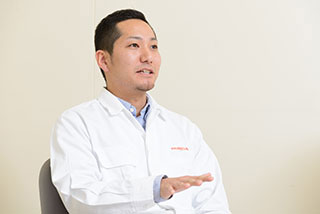
Shinya Morooka — Finished vehicle stress testing
“Titanium is, of course, much stronger than plastic. In a crash testing, it was clear to see that it could offer excellent performance when used on a motocross machine.”
Lighter, stronger, thinner… I also like going off-road riding, but the physical demands can be pretty extreme. As an occasional hobby rider, I find myself panting after only about 10 minutes of riding. So when it comes to heavy 450cc class motocross machines, lighter weight offers clear benefits in terms of maneuverability.
However, titanium is known for being difficult to use in press molding. What kind of challenges were confronted in the tank’s production?
Motoaki Takashima — Press molding department
“The press molding of titanium entailed a lot of trial and error. The way the titanium stretches when pressed differs depending on the orientation of the plate material. As a result, the titanium plate would stick to the press die, and we found that whereas some sections could be molded, other parts became crimped and torn because the plate wasn’t able to extend deeply enough into the die. We had to overcome numerous issues before we discovered these important characteristics about the metal.”
Chihara —
“When making the titanium plate, we roll the titanium material in a roller. However, the material has a tendency to stretch differently in the direction being rolled and the direction perpendicular to that (in-plane anisotropy). This increases difficulty in press molding it.”
Ryuji Masuda — Press molding simulation analysis
“Another factor that contributed to our difficulties was that, rather than using titanium plate, we had mainly used steel plate in our press molding simulations up till that point. The reason why we had to make so many press molding prototypes was that the theoretical simulation analysis technology was still not fully developed, and was not functioning very well.”
As there were no prior examples of press molding titanium plate into complex shapes such as a motorcycle tank, the team’s pioneering struggles continued.

Kenji Makihara — Welding department
“Due to titanium’s low thermal conductivity and differences in its unique electrical resistance, we also had difficulty with welding. We ran into much greater difficulty compared to our experience using ordinary steel plate. We needed to uncover all the quirky characteristics of titanium through trial and error before we could even begin manufacturing.
“Thus, titanium entailed a lot of difficulty in manufacturing. We needed to press the titanium plate in order to form the bottom and top halves of the tank, and then weld the two halves together. Having acquired that know-how, the tank we had worked so hard to achieve was extremely simple, and proved to be a tough and lightweight product endowed with the durability needed for motocross.”
Hirano —
“We tried to generate strength through design. Our goal was make a product that required no reinforcing members be added afterwards. As we were looking for both strength and lightness, the degree of difficulty in the press molding process was increased. However, this was an area where we could not compromise in our pursuit of performance.”
The CRF450R’s titanium tank is certainly lightweight. However, its designers also gave it a stamp of approval for having excellent corrosion resistance and safety aspects as a container for holding fuel.
The Success Achieved in Making the CRF450R’S Fuel Tank Led to a Titanium Tank Being Created for the CBR1000RR SP/SP2.
In the early stages of the CBR1000RR’s development, the designers considered using an aluminum tank. However, in consideration of the processes involved, as well as the cost, weight, etc. of mass production, and encouraged by the Kumamoto Factory’s slogan of “Let’s do it!”, the designers decided to switch to a titanium tank, which despite being expensive as a material, was far lighter and offered greater product appeal.

Masanori Usa — CBR1000RR design engineer
“As the steel fuel tank we created for the latest iteration of the CBR1000RR was fully 300 grams lighter than that used on the 2014 model, even our steel tanks featured a lightness we could boast about to our rivals.
“The biggest challenge we faced in creating the titanium fuel tank for the CBR1000RR SP/SP2 was performing the press molding of a tank that was larger, more complex, and more deeply pressed than the CBR tank based on the production technology we had established for the CRF.”
Cutting-edge press molding technology developed for a titanium tank. Production of this complex structure was enormously difficult.
Usa —
“We thought we could deliver up a more impressive version of the CBR1000RR, for which lightness is key. This is the great advantage of having a research laboratory and manufacturing plant in the same location, such as in Kumamoto. We were immediately able to talk face to face if any problems arose. We were thus able to find the direction we needed to move.”
Since they were coming up with new manufacturing methods, it was critical to have even more cooperation between departments than normal. So, how heavy is the resulting titanium tank?
Usa —
“It’s 1.7 kilograms, as opposed to 3 kilograms for the steel tank. For a component part like this that is mounted in such a high position, its lightness has a dramatic effect on maneuverability. It may be light, but we also took nothing for granted in regards to vibration.”
Before working on this story, I had encountered the CBR1000RR SP when shooting some photos for a magazine. I was amazed at how light it was when I pushed it to change its position. This model is also equipped with a lithium ion battery and other details that contribute to even lighter weight, so the titanium tank is not the only thing responsible for the CBR’s remarkable feeling of lightness. That said, its lightness and resulting enhancements to overall performance are essential to improving the sense of unified integration that is so important to achieving the highest levels of riding comfort and control.
The CBR1000RR is a model that pursues the ultimate in riding ease and comfort in a high-performance sports bike. Careful attention was also paid to its fuel tank design in order to enable the rider to move more freely.
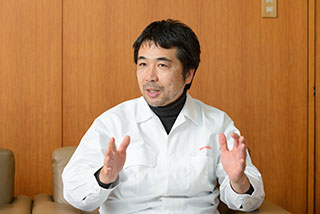
Koji Mizuta — CBR1000RR body design
“In the case of the CBR, our test riders presented us with some tough demands regarding the tank shape to ensure that it didn’t impede rider movement. Upon making a running prototype after the clay model used in design review, we made additional changes in response to requests for parts to be reshaped for greater mobility. Of course, trimming the shape of the tank reduced its capacity. We repeated this process of correcting the tank shape many times in units of mere millimeters while striving to maintain ample tank capacity. Since we had to attach a four-piece exterior top shelter over the titanium tank, we also needed to consider clearance with the tank in areas where the plate thickness was superimposed. For the CBR1000RR, we aimed for compactness in addition to lightness; hence the role of design was to strike a balance between tank capacity, ease of rider movement, and compactness.”
Since this motorcycle is a high-performance Super Sports machine, considerable attention was devoted to feel and texture when the rider hugs the tank between the knees. The CBR1000RR belongs in the top of its class in terms of performance, lightness, handling and so on. Of course, its fuel tank is not the only factor behind this, however, it has no doubt raised user expectations.
Mizuta —
“For example, if you’re able to check out an actual bike at a dealership, please get up close to the tank, straddle it and lie on it. I think you’ll be able to appreciate the minute calculations involved in how the Fireblade’s tank has been shaped for riding.”
Usa —
“On the circuit, the rider usually lies on the tank when charging down the straights. At this time, if you rest the jaw of your helmet on the tank, the screen will come to just the right height. That is the kind of compactness we were aiming for.”
The history of mass-produced titanium fuel tanks begins with the CRF450R and CBR1000RR SP/SP2. Titanium’s lightness imparts greater maneuverability, which adds to any rider’s enjoyment.
This gives rise to the joy manifested in expressions such as “I never realized riding could be so much fun!” For me, such wonder represents a victory for hobby riders.
The challenges of motorcycle making will continue, and with it our victories will come closer to home. I pondered these thoughts as I bade farewell to Kumamoto.
CBR1000RR SP/SP2 + CRF450R Titanium Tank Processes
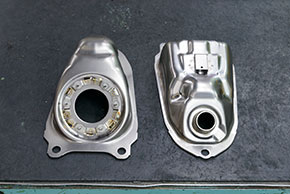
1. The top and bottom sections of the CRF450R’s press-molded titanium fuel tank. Each piece is carefully inspected with the naked eye.
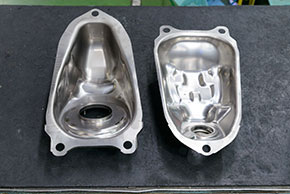
2. Bottom (left) and top (right) sections of the CRF450R’s titanium tank following press molding and trimming.
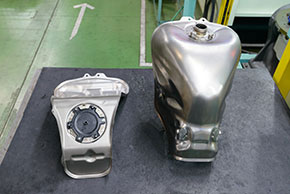
3. The CBR1000RR SP/SP2’s titanium tank following press molding and trimming.
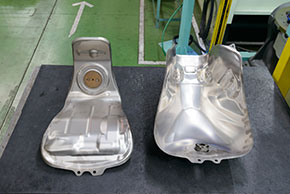
4. CBR1000RR SP/SP2 titanium tank sections after trimming. Comparison with the CRF450R tank shown in Photo 2 clearly shows how complex the shape is, and how deeply the press molding is done on a single sheet of metal.
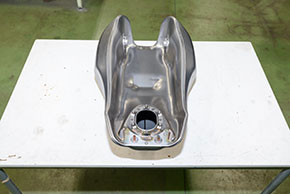
5. CRF450R titanium tanks waiting for seam welding of the top and bottom sections following attachment by robotic welding of the fuel pump mount. The area where the top and bottom parts overlap is the welded section. The tank is completed by welding entirely around this seam line.
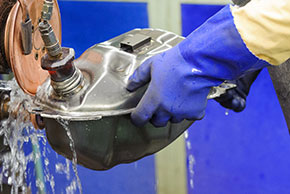
6. The seam welding is carried out while the tank seam is sandwiched between upper and lower rollers. The highly skilled operator gradually moves the tank forward in unison with the rotating speed of the seam welder rollers. Water is applied to control the welding heat while working.

7. In the case of the titanium tank for the CBR1000RR SP/SP2, the shape of the seam is three-dimensional, hence skill is required to move the tank through the welding machine. Seasoned operators carry out the welding work.
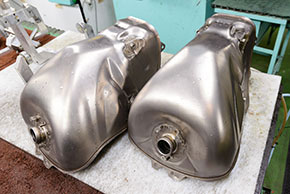
8. These titanium tanks have passed testing. They will be dried and sent to the next stage in the manufacturing process. The tank’s basic assembly and inspection jobs are finished at this point.
- TOP
- Flangeless Fuel Tank
- Titanium Fuel Tank

